Detailed Analysis of Australian Greens Environment Policy and EPA
VerifiedAdded on 2021/02/22
|5
|1275
|29
Report
AI Summary
This report provides an analysis of the Australian Greens' environment policy, emphasizing the role of the Environment Protection Authority (EPA). It examines environmental issues such as air and water pollution and waste management, highlighting the EPA's function as an independent advisor and its involvement in resource assessment and policy recommendations. The study delves into policy actors, including government, businesses, and NGOs, and their influence on public policy. It explores the four stages of the policy process: problem identification, policy formulation, implementation, and evaluation. The EPA's participation in promoting environmental awareness and its impact, both positive and negative, on public policy are also discussed, with a focus on improving coordination and communication to effectively deliver environmental protection strategies. The report concludes by summarizing the EPA's role in protecting the environment and creating awareness among the public.
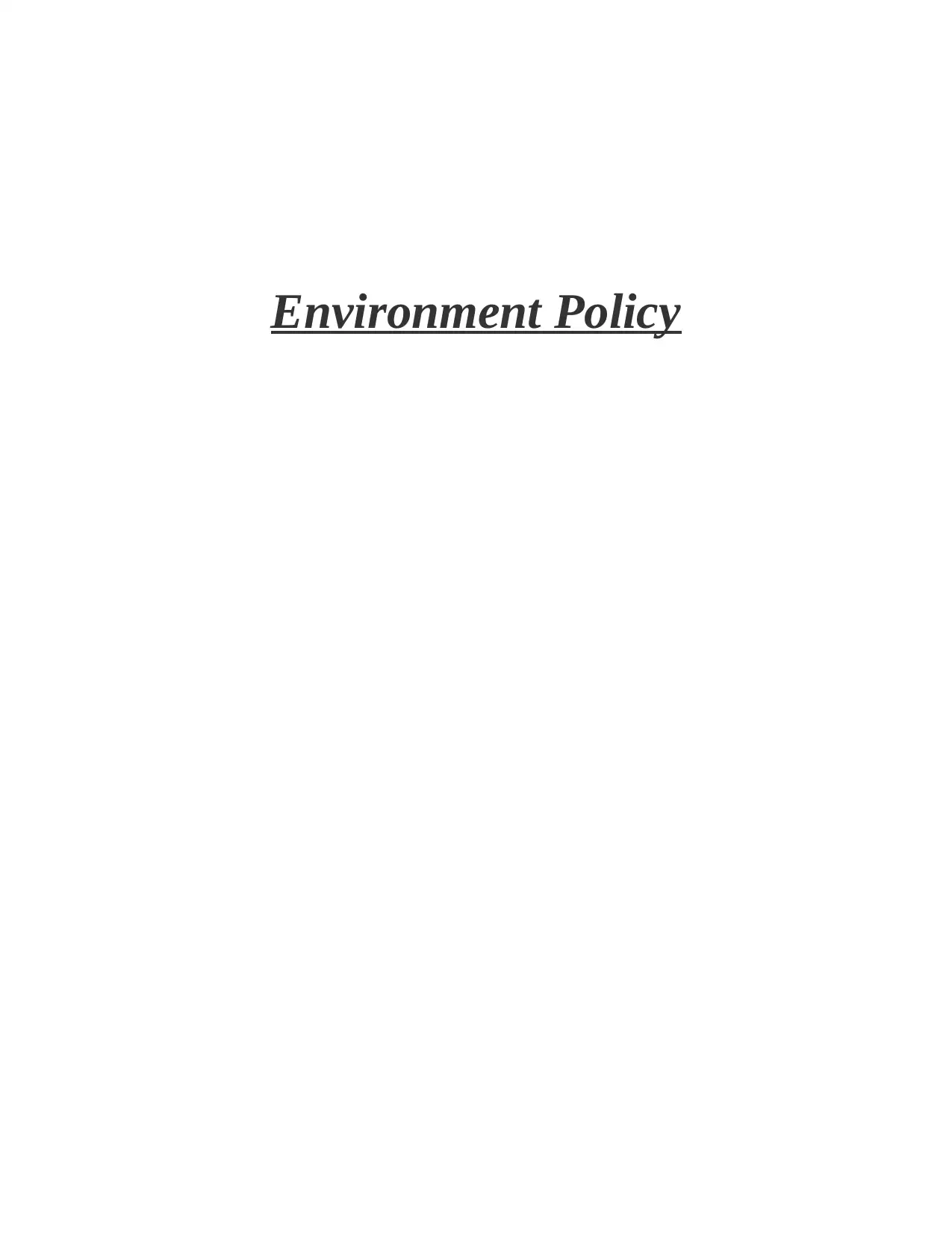
Environment Policy
Paraphrase This Document
Need a fresh take? Get an instant paraphrase of this document with our AI Paraphraser
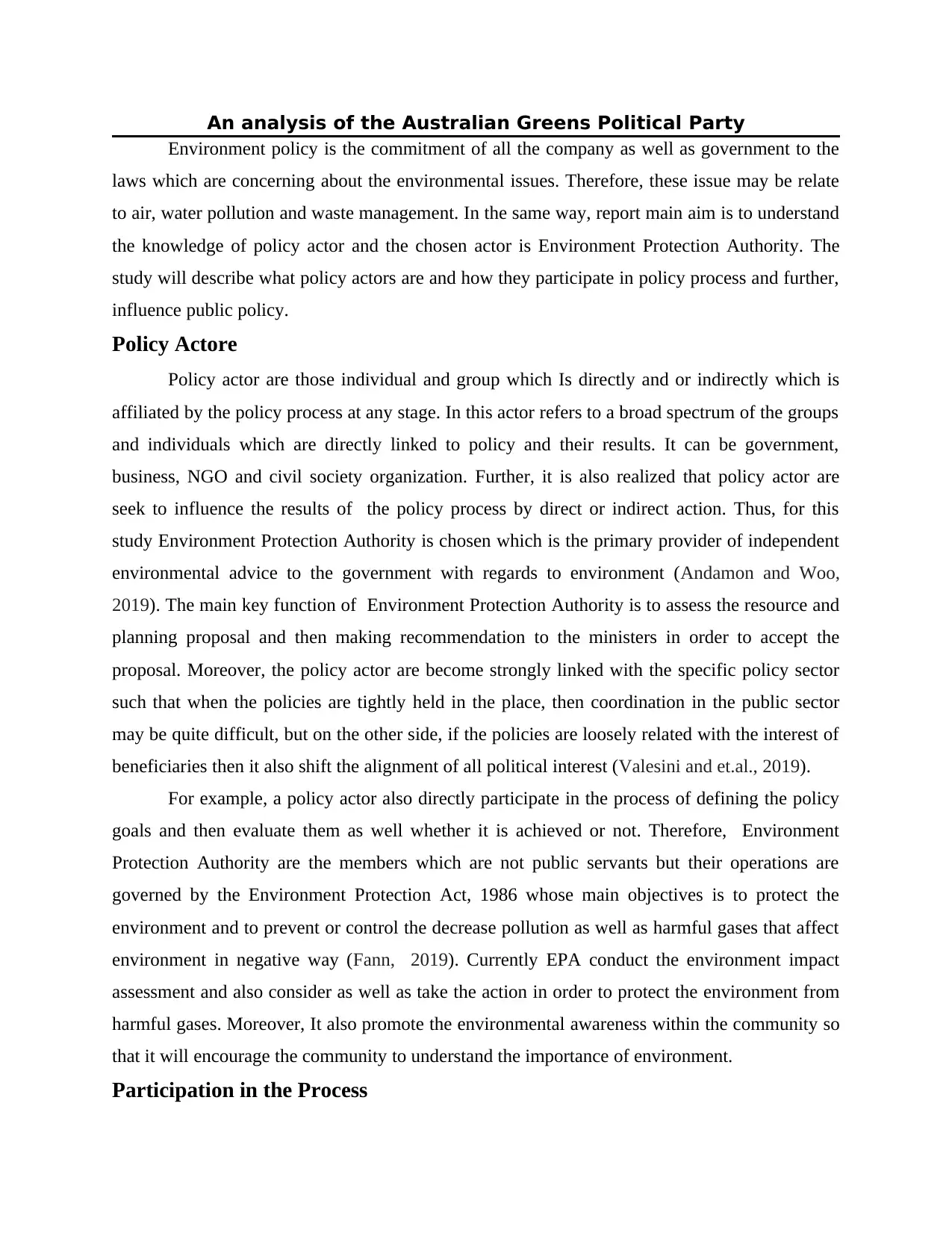
An analysis of the Australian Greens Political Party
Environment policy is the commitment of all the company as well as government to the
laws which are concerning about the environmental issues. Therefore, these issue may be relate
to air, water pollution and waste management. In the same way, report main aim is to understand
the knowledge of policy actor and the chosen actor is Environment Protection Authority. The
study will describe what policy actors are and how they participate in policy process and further,
influence public policy.
Policy Actore
Policy actor are those individual and group which Is directly and or indirectly which is
affiliated by the policy process at any stage. In this actor refers to a broad spectrum of the groups
and individuals which are directly linked to policy and their results. It can be government,
business, NGO and civil society organization. Further, it is also realized that policy actor are
seek to influence the results of the policy process by direct or indirect action. Thus, for this
study Environment Protection Authority is chosen which is the primary provider of independent
environmental advice to the government with regards to environment (Andamon and Woo,
2019). The main key function of Environment Protection Authority is to assess the resource and
planning proposal and then making recommendation to the ministers in order to accept the
proposal. Moreover, the policy actor are become strongly linked with the specific policy sector
such that when the policies are tightly held in the place, then coordination in the public sector
may be quite difficult, but on the other side, if the policies are loosely related with the interest of
beneficiaries then it also shift the alignment of all political interest (Valesini and et.al., 2019).
For example, a policy actor also directly participate in the process of defining the policy
goals and then evaluate them as well whether it is achieved or not. Therefore, Environment
Protection Authority are the members which are not public servants but their operations are
governed by the Environment Protection Act, 1986 whose main objectives is to protect the
environment and to prevent or control the decrease pollution as well as harmful gases that affect
environment in negative way (Fann, 2019). Currently EPA conduct the environment impact
assessment and also consider as well as take the action in order to protect the environment from
harmful gases. Moreover, It also promote the environmental awareness within the community so
that it will encourage the community to understand the importance of environment.
Participation in the Process
Environment policy is the commitment of all the company as well as government to the
laws which are concerning about the environmental issues. Therefore, these issue may be relate
to air, water pollution and waste management. In the same way, report main aim is to understand
the knowledge of policy actor and the chosen actor is Environment Protection Authority. The
study will describe what policy actors are and how they participate in policy process and further,
influence public policy.
Policy Actore
Policy actor are those individual and group which Is directly and or indirectly which is
affiliated by the policy process at any stage. In this actor refers to a broad spectrum of the groups
and individuals which are directly linked to policy and their results. It can be government,
business, NGO and civil society organization. Further, it is also realized that policy actor are
seek to influence the results of the policy process by direct or indirect action. Thus, for this
study Environment Protection Authority is chosen which is the primary provider of independent
environmental advice to the government with regards to environment (Andamon and Woo,
2019). The main key function of Environment Protection Authority is to assess the resource and
planning proposal and then making recommendation to the ministers in order to accept the
proposal. Moreover, the policy actor are become strongly linked with the specific policy sector
such that when the policies are tightly held in the place, then coordination in the public sector
may be quite difficult, but on the other side, if the policies are loosely related with the interest of
beneficiaries then it also shift the alignment of all political interest (Valesini and et.al., 2019).
For example, a policy actor also directly participate in the process of defining the policy
goals and then evaluate them as well whether it is achieved or not. Therefore, Environment
Protection Authority are the members which are not public servants but their operations are
governed by the Environment Protection Act, 1986 whose main objectives is to protect the
environment and to prevent or control the decrease pollution as well as harmful gases that affect
environment in negative way (Fann, 2019). Currently EPA conduct the environment impact
assessment and also consider as well as take the action in order to protect the environment from
harmful gases. Moreover, It also promote the environmental awareness within the community so
that it will encourage the community to understand the importance of environment.
Participation in the Process
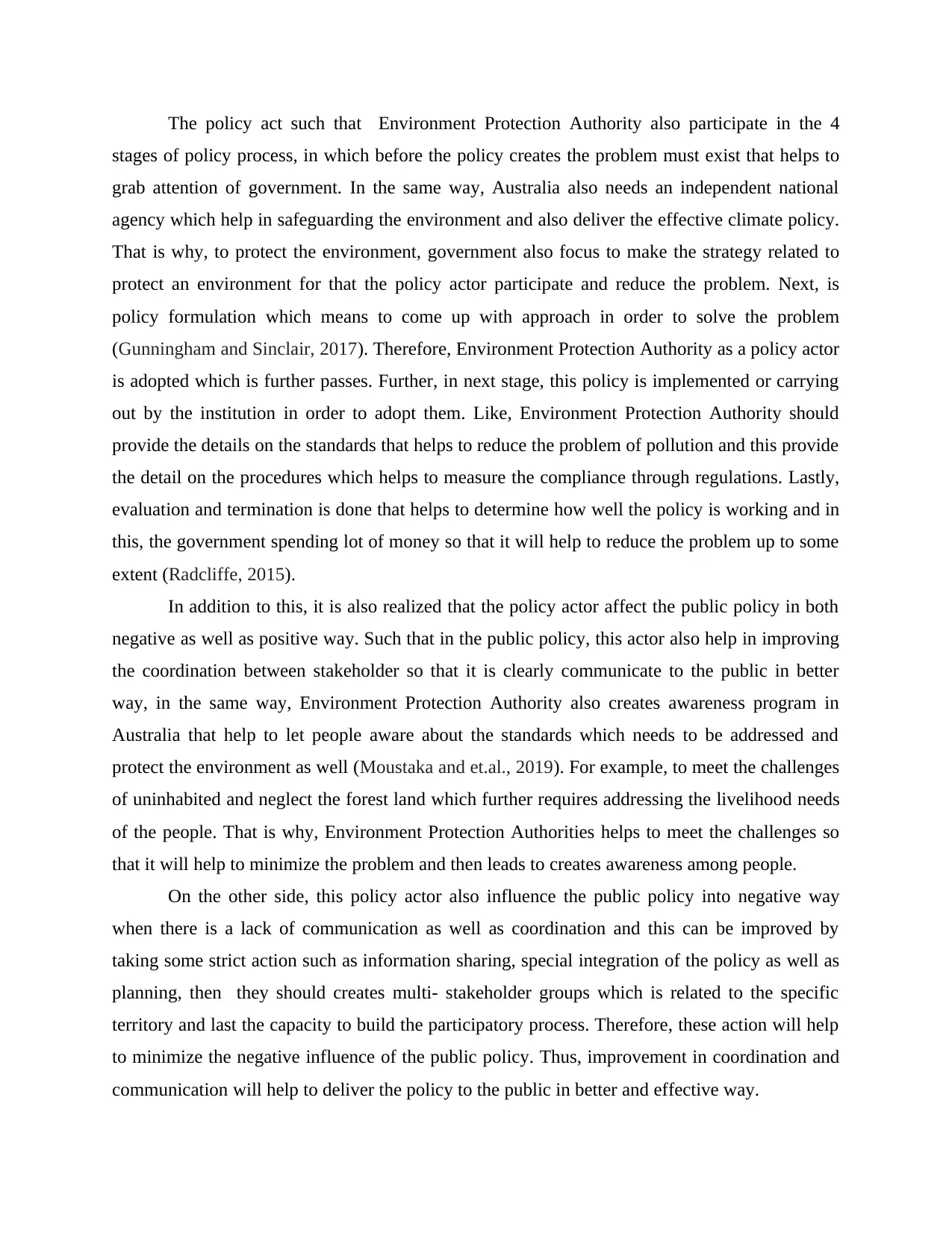
The policy act such that Environment Protection Authority also participate in the 4
stages of policy process, in which before the policy creates the problem must exist that helps to
grab attention of government. In the same way, Australia also needs an independent national
agency which help in safeguarding the environment and also deliver the effective climate policy.
That is why, to protect the environment, government also focus to make the strategy related to
protect an environment for that the policy actor participate and reduce the problem. Next, is
policy formulation which means to come up with approach in order to solve the problem
(Gunningham and Sinclair, 2017). Therefore, Environment Protection Authority as a policy actor
is adopted which is further passes. Further, in next stage, this policy is implemented or carrying
out by the institution in order to adopt them. Like, Environment Protection Authority should
provide the details on the standards that helps to reduce the problem of pollution and this provide
the detail on the procedures which helps to measure the compliance through regulations. Lastly,
evaluation and termination is done that helps to determine how well the policy is working and in
this, the government spending lot of money so that it will help to reduce the problem up to some
extent (Radcliffe, 2015).
In addition to this, it is also realized that the policy actor affect the public policy in both
negative as well as positive way. Such that in the public policy, this actor also help in improving
the coordination between stakeholder so that it is clearly communicate to the public in better
way, in the same way, Environment Protection Authority also creates awareness program in
Australia that help to let people aware about the standards which needs to be addressed and
protect the environment as well (Moustaka and et.al., 2019). For example, to meet the challenges
of uninhabited and neglect the forest land which further requires addressing the livelihood needs
of the people. That is why, Environment Protection Authorities helps to meet the challenges so
that it will help to minimize the problem and then leads to creates awareness among people.
On the other side, this policy actor also influence the public policy into negative way
when there is a lack of communication as well as coordination and this can be improved by
taking some strict action such as information sharing, special integration of the policy as well as
planning, then they should creates multi- stakeholder groups which is related to the specific
territory and last the capacity to build the participatory process. Therefore, these action will help
to minimize the negative influence of the public policy. Thus, improvement in coordination and
communication will help to deliver the policy to the public in better and effective way.
stages of policy process, in which before the policy creates the problem must exist that helps to
grab attention of government. In the same way, Australia also needs an independent national
agency which help in safeguarding the environment and also deliver the effective climate policy.
That is why, to protect the environment, government also focus to make the strategy related to
protect an environment for that the policy actor participate and reduce the problem. Next, is
policy formulation which means to come up with approach in order to solve the problem
(Gunningham and Sinclair, 2017). Therefore, Environment Protection Authority as a policy actor
is adopted which is further passes. Further, in next stage, this policy is implemented or carrying
out by the institution in order to adopt them. Like, Environment Protection Authority should
provide the details on the standards that helps to reduce the problem of pollution and this provide
the detail on the procedures which helps to measure the compliance through regulations. Lastly,
evaluation and termination is done that helps to determine how well the policy is working and in
this, the government spending lot of money so that it will help to reduce the problem up to some
extent (Radcliffe, 2015).
In addition to this, it is also realized that the policy actor affect the public policy in both
negative as well as positive way. Such that in the public policy, this actor also help in improving
the coordination between stakeholder so that it is clearly communicate to the public in better
way, in the same way, Environment Protection Authority also creates awareness program in
Australia that help to let people aware about the standards which needs to be addressed and
protect the environment as well (Moustaka and et.al., 2019). For example, to meet the challenges
of uninhabited and neglect the forest land which further requires addressing the livelihood needs
of the people. That is why, Environment Protection Authorities helps to meet the challenges so
that it will help to minimize the problem and then leads to creates awareness among people.
On the other side, this policy actor also influence the public policy into negative way
when there is a lack of communication as well as coordination and this can be improved by
taking some strict action such as information sharing, special integration of the policy as well as
planning, then they should creates multi- stakeholder groups which is related to the specific
territory and last the capacity to build the participatory process. Therefore, these action will help
to minimize the negative influence of the public policy. Thus, improvement in coordination and
communication will help to deliver the policy to the public in better and effective way.
⊘ This is a preview!⊘
Do you want full access?
Subscribe today to unlock all pages.

Trusted by 1+ million students worldwide
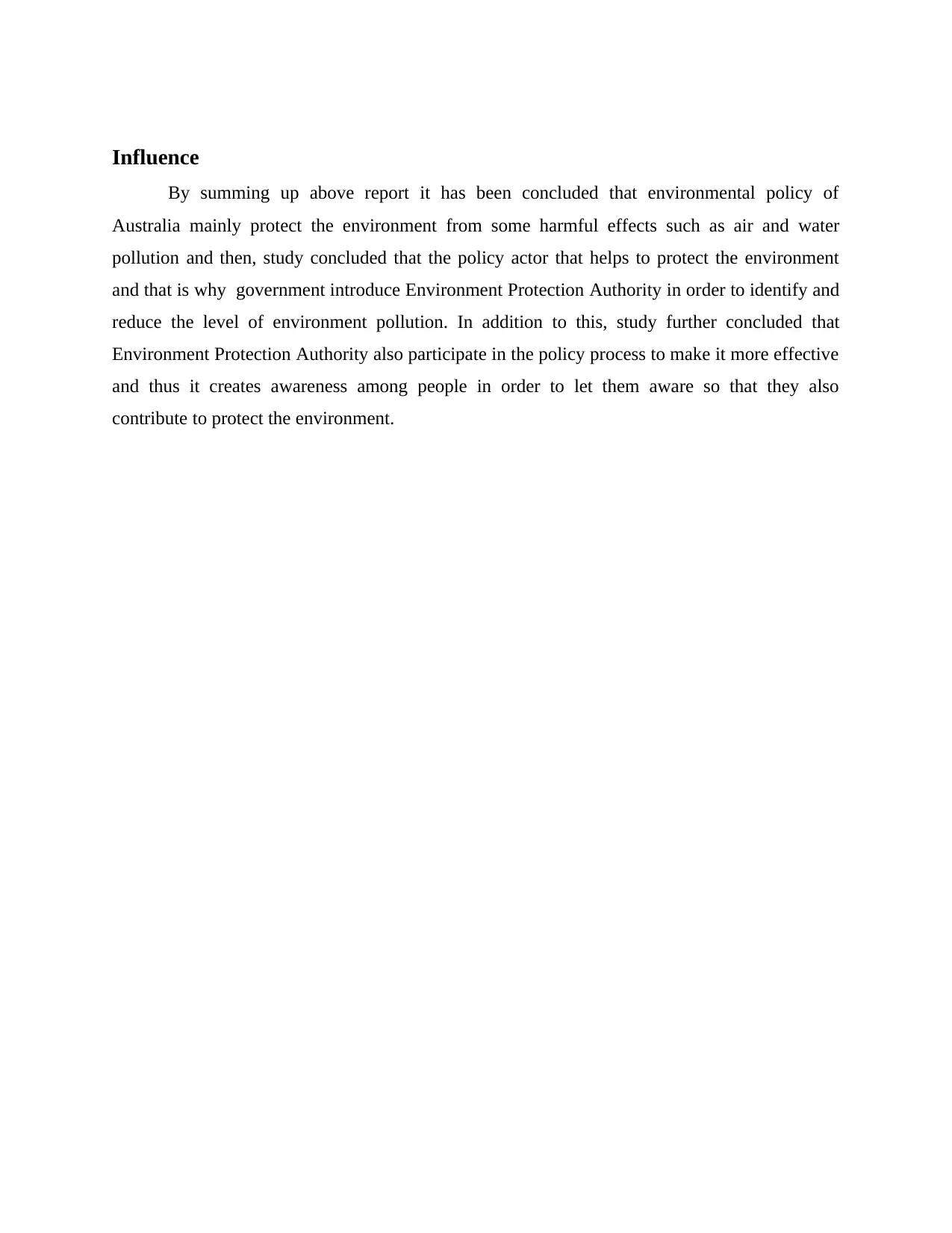
Influence
By summing up above report it has been concluded that environmental policy of
Australia mainly protect the environment from some harmful effects such as air and water
pollution and then, study concluded that the policy actor that helps to protect the environment
and that is why government introduce Environment Protection Authority in order to identify and
reduce the level of environment pollution. In addition to this, study further concluded that
Environment Protection Authority also participate in the policy process to make it more effective
and thus it creates awareness among people in order to let them aware so that they also
contribute to protect the environment.
By summing up above report it has been concluded that environmental policy of
Australia mainly protect the environment from some harmful effects such as air and water
pollution and then, study concluded that the policy actor that helps to protect the environment
and that is why government introduce Environment Protection Authority in order to identify and
reduce the level of environment pollution. In addition to this, study further concluded that
Environment Protection Authority also participate in the policy process to make it more effective
and thus it creates awareness among people in order to let them aware so that they also
contribute to protect the environment.
Paraphrase This Document
Need a fresh take? Get an instant paraphrase of this document with our AI Paraphraser
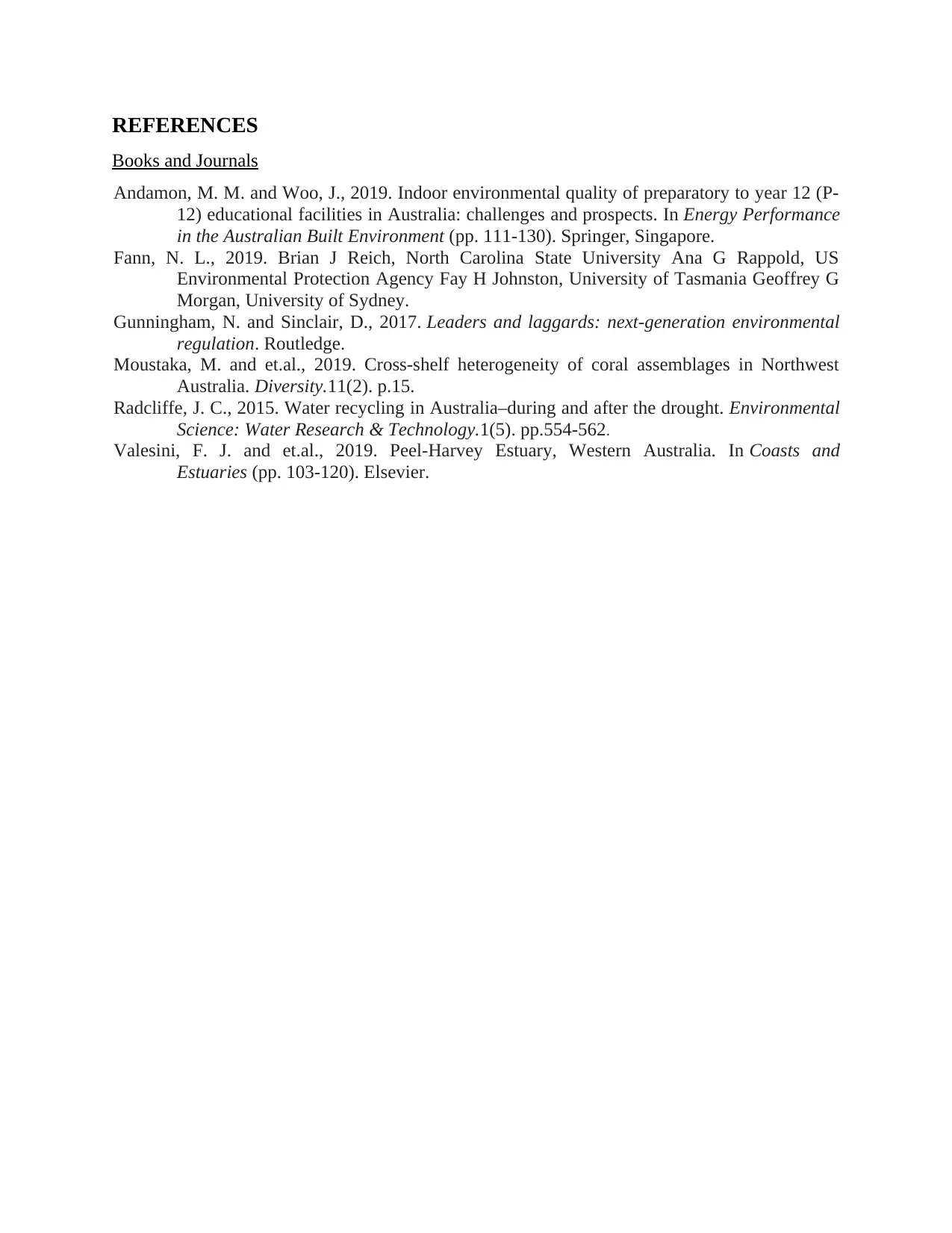
REFERENCES
Books and Journals
Andamon, M. M. and Woo, J., 2019. Indoor environmental quality of preparatory to year 12 (P-
12) educational facilities in Australia: challenges and prospects. In Energy Performance
in the Australian Built Environment (pp. 111-130). Springer, Singapore.
Fann, N. L., 2019. Brian J Reich, North Carolina State University Ana G Rappold, US
Environmental Protection Agency Fay H Johnston, University of Tasmania Geoffrey G
Morgan, University of Sydney.
Gunningham, N. and Sinclair, D., 2017. Leaders and laggards: next-generation environmental
regulation. Routledge.
Moustaka, M. and et.al., 2019. Cross-shelf heterogeneity of coral assemblages in Northwest
Australia. Diversity.11(2). p.15.
Radcliffe, J. C., 2015. Water recycling in Australia–during and after the drought. Environmental
Science: Water Research & Technology.1(5). pp.554-562.
Valesini, F. J. and et.al., 2019. Peel-Harvey Estuary, Western Australia. In Coasts and
Estuaries (pp. 103-120). Elsevier.
Books and Journals
Andamon, M. M. and Woo, J., 2019. Indoor environmental quality of preparatory to year 12 (P-
12) educational facilities in Australia: challenges and prospects. In Energy Performance
in the Australian Built Environment (pp. 111-130). Springer, Singapore.
Fann, N. L., 2019. Brian J Reich, North Carolina State University Ana G Rappold, US
Environmental Protection Agency Fay H Johnston, University of Tasmania Geoffrey G
Morgan, University of Sydney.
Gunningham, N. and Sinclair, D., 2017. Leaders and laggards: next-generation environmental
regulation. Routledge.
Moustaka, M. and et.al., 2019. Cross-shelf heterogeneity of coral assemblages in Northwest
Australia. Diversity.11(2). p.15.
Radcliffe, J. C., 2015. Water recycling in Australia–during and after the drought. Environmental
Science: Water Research & Technology.1(5). pp.554-562.
Valesini, F. J. and et.al., 2019. Peel-Harvey Estuary, Western Australia. In Coasts and
Estuaries (pp. 103-120). Elsevier.
1 out of 5
Related Documents
Your All-in-One AI-Powered Toolkit for Academic Success.
+13062052269
info@desklib.com
Available 24*7 on WhatsApp / Email
![[object Object]](/_next/static/media/star-bottom.7253800d.svg)
Unlock your academic potential
Copyright © 2020–2025 A2Z Services. All Rights Reserved. Developed and managed by ZUCOL.





